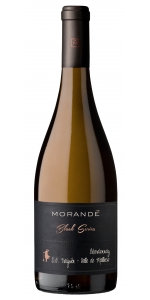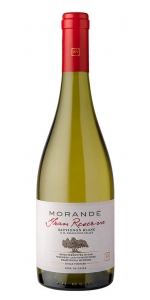Wine from Vina Morande

When Pablo Morandé founded Viña Morandé in 1996, he did it with a great vision for the future and with the same audacity that drove him, years earlier, to be the first person to plant vines in the Casablanca Valley. They also aimed at using less renowned varieties that have been traditionally grown there. It may be worth remembering that, since the very beginning of Viña Morandé, the old vineyards grown in the Secano have had a special meaning for the winery. On one hand, Maule, and particularly the area of Cauquenes, is the place of birth of their founder. And on the other, the winery has developed an important viticultural work throughout the years in its different terroirs, crafting wines that have been present since the first day in their portfolio.
Today Casablanca is one of the most internationally recognized wine regions for the quality of its wines. Its primary geographic condition is its maritime influence, which enters from the Pacific Ocean and produces morning fog that moderates the temperatures. This characteristic encourages optimal vineyard development, which demands special care to reach the desired ripeness. The varieties that grow best in Casablanca are Chardonnay, Sauvignon Blanc, and Pinot Noir.
The Belen property is located in the Lo Ovalle sector of the Casablanca Valley. The 130 hectares of vineyards were planted in two stages, the first in 2004 and the second in 205. The vineyard density is 10,101 plants/hectare with a distance of 1.5 meters between rows and 0.00 meters between plants.
Morande Black Series Chardonnay is made from 100 percent Chardonnay.
Malleco represents the exploration of one of the most extreme valleys in Chile for wine production. A new wine frontier, an ideal terroir to produce high-end Chardonnay in Chile, with a different style from other outstanding origins such as Limarí –which offers wines with marked minerality– or Aconcagua Costa –which delivers sharp acidity and great power. The Traiguen area in the Malleco valley produces wines of great tension and fruity austerity, as well as complexity, balance and finesse. A very typical style of Chardonnay marked by elegance, verticality on the palate and subtlety on the nose and mouth.
The wine offers a bright pale yellow color, intense and elegant aromas of citrus fruits and green apples as well as hints of nuts, such as hazelnuts and roasted chestnuts. A tense and fresh acidity on the palate, and a vertical structure in the mouth. Very fine and complex, its long persistence highlights the austere character of its fruit and a delicate minerality.
Shellfish and fish of intense flavor, such as smoked salmon, swordfish, giant perch, and white meats, poultry.
Review:
"Fresh and pure on the nose with green fruits and lots of star fruit, a hint of flint and a slight creamy edge. Subtle and bright with a tense mid-palate that creates a creamy but fresh mouthfeel. Medium- to full-bodied and long. Drink now."
- James Suckling (February 2023), 94 pts
Morande Gran Reserva Sauvignon Blanc is made from 100 percent Sauvignon Blanc
The grapes for this wine come from Morande's estate located in Casablanca, a few miles from the Pacific Ocean. This valley is well-known for its cool climate that allows to obtain small clusters and grapes that develop colors, aromas, and flavors that are characteristic of a slow ripening process. Of limited production, the vineyard is trellised to the vertical shoot position and grows on clayey, granitic soils of low fertility that give life to remarkable wines.
Bright straw-yellow color, delicate aromas with fresh herbs, honey and orange-blossom, combined with white fruit and citrus fruit. The palate shows complex flavors, with edgy, mineral freshness and outstanding citrusy notes of grapefruit, herbs and white peaches. It is persistent, elegant and with a structure that makes for good aging potential.
The grapes were picked by hand in 10-kilo boxes. A large percentage was whole-bunch pressed and the rest underwent a cold maceration for eight hours in the press. The must fermented mainly in French oak foudres, but a part also in cement eggs. The wine was kept in both its containers during six months before bottling.
Pair with white meat, fish and seafood, fresh cheese.
- back
Selected Options
Wineries
Categories
Pricing
Countries
Regions
Grape Types
Wineries
Organic/Free Shipping
Matthews Cabernet Sauvignon Columbia Valley is made from 76% Cabernet Sauvignon, 15%Merlot, 6% Cabernet Franc, 2% Petit Verdot, 1% Malbec.
The 2021 Columbia Valley Cabernet Sauvignon is deep ruby in the glass with purple hues. The rich bouquet of spiced black plum and cocoa nib are balanced with aromas of fresh earth and crushed flint. Intense and opulent flavors of ripe blackberry, cedar, mocha, and black currant coat the broad and balanced palate and the ripe tannin creates a perfect frame for the lush fruit expression. Cherry cordial and cola linger on the long, quenching finish.
Review:
A wonderfully balanced Cabernet with tremendous purity of fruit and a brilliant freshness. A blend of sites across the Columbia Valley focused on the Horse Heaven Hills, Red Mountain and Royal Slope. Smoky violet notes and crushed stone follow graphite minerality and dusty berries. The palate is delightfully distinguished. Cabernet and savoury herbs mingle with red berries, black brambles, and a brilliant mineral tone.
-Decanter 94 Points
Coming out strong out of the gate, the 2021 ‘Columbia Valley’ Cabernet Sauvignon is nearly all varietal. Dark chocolate shavings, baking spices and anise come together on the nose. The palate is beautifully balanced with a seamless texture and great sense of weight, with heady roasted date and black currant flavors. Generous and rich, this is a gorgeous showing from 2021. This is a serious value to purchase by the case.
- Owen Bargreen 94 Points
Precise and expressive, with handsome flavors of blackberry, bay leaf and espresso that build richness and structure toward refined tannins.
-Wine Spectator 93 Points
The 2021 Cabernet Sauvignon Columbia Valley is spicy, showing off a gentle peppery tinge and dusty rose tones that give way to dried black cherries. This is wonderfully crisp and refined, with silky textures and depths of dark red fruit propelled by juicy acidity. It tapers off long and structured, yet the tannins are quite sweet. The 2021 finishes with a pleasant crunch and a lingering licorice tinge.
-Vinous 93 Points
The 2021 Cabernet Sauvignon is based on 76% Cabernet Sauvignon, 15% Merlot, 6% Cabernet Franc, 2% Petit Verdot, and 1% Malbec. A rocking wine offering ample red and black plum-like fruit, chocolate, tobacco, and subtle violet-like aromas and flavors, I t's full-bodied and has a terrific mid-palate, velvety tannins, and a great finish.
-Jeb Dunnuck 93 Points
Ferren Pinot Noir Silver Eagle Vineyard is made from 100 percent Chardonnay.
Winemaker Matt Courtney learned what he knows of Chardonnay on the Sonoma Coast during his eight-year apprenticeship with Helen Turley of Marcassin Vineyards. At Ferren he employs artisan methods crafting his wines in small lots from single-vineyard sources with native fermentation and without fining or filtration. | Falling Bright
Silver Eagle Vineyard rests atop Stoetz Ridge, the land mass that divides the remote Sonoma Coast from the Russian River Valley. This vineyard experiences both the cooling ocean breezes of the nearby Pacific, as well as the warmth of the interior valley. The Chardonnay made from this unique confluence of climates is extraordinary; a fascinating juxtaposition of briny minerality and candied citrus.
Review:
"A stunning, concentrated and expressive Chardonnay, with notes of orange blossoms, candied lemon peel, crunchy star fruit and pear. Offers accents of salted Marcona almond, tarragon and lemon verbena, plus a vibrant thread of acidity, along with lingering hints of white tea, green cardamom and ginger. Drink now through 2037.—M.W.”
- Wine Spectator (May 2025), 95 pts






